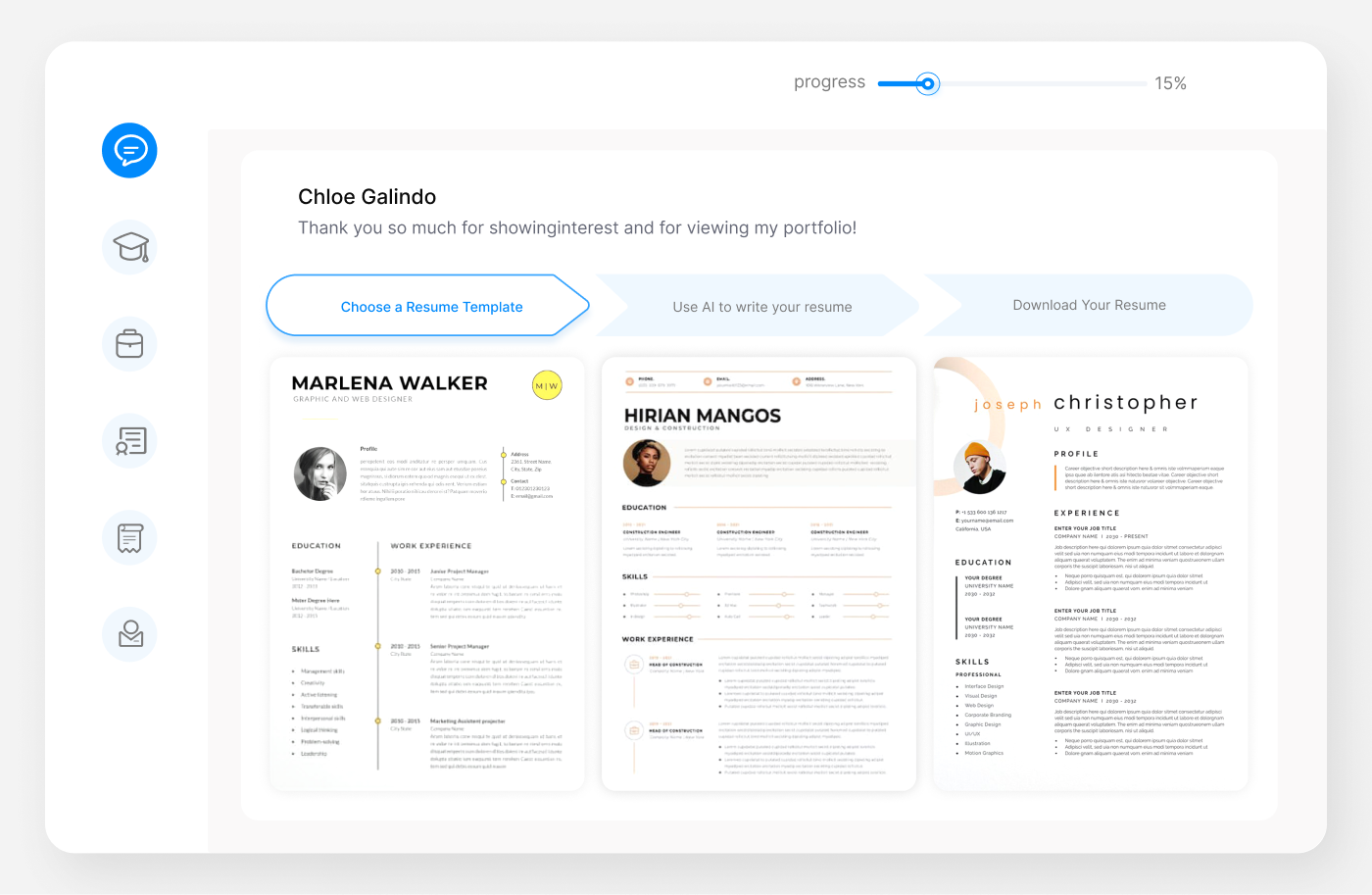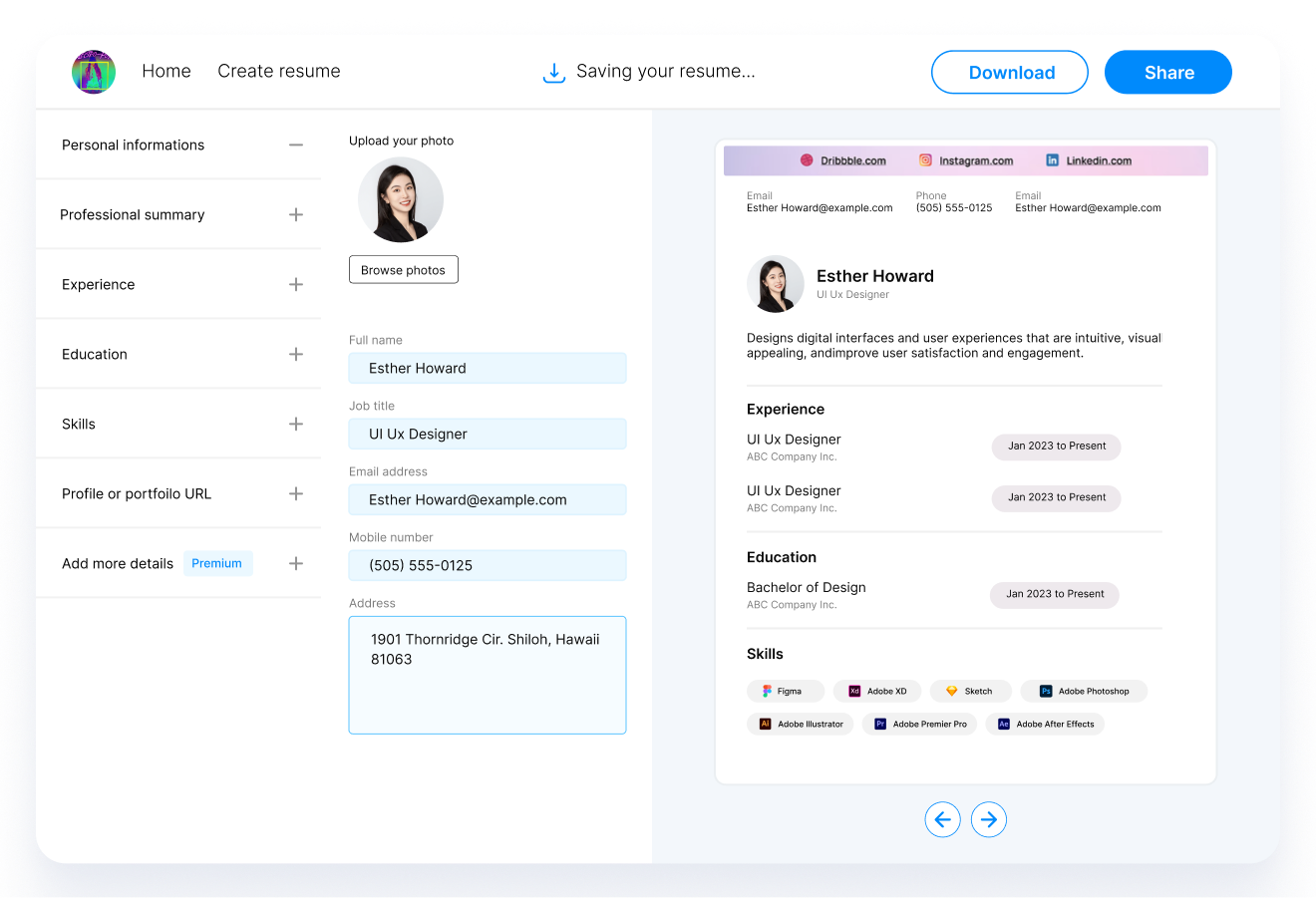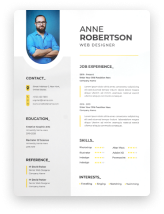In the competitive field of physical therapy, standing out with a well-crafted resume is crucial for career advancement. Whether you're a seasoned practitioner or a new graduate, understanding how to highlight your expertise, experience, and dedication to patient care is key. This guide provides essential insights into crafting a resume that not only showcases your qualifications but also resonates with healthcare employers. Dive into our expert tips and examples to build a resume that opens doors to your next career opportunity.

Physical Therapist Resume Example
Megan Thompson, PT, DPT Los Angeles, CA
(555) 123-4567 | megan.thompson@example.com
LinkedIn.com/in/meganthompsonpt
SUMMARY
Dedicated and patient-focused licensed Physical Therapist with over 8 years of experience in outpatient orthopedic and pediatric settings. Expert in designing tailored therapy programs to meet individual patient needs, enhancing mobility, alleviating pain, and improving overall physical health. Proven track record in leading rehabilitation teams and collaborating with healthcare professionals to provide holistic care. Committed to ongoing professional development and evidence-based practice.
PROFESSIONAL EXPERIENCE
Senior Physical Therapist, Healing Hands Therapy Center
Los Angeles, CA July 2018 -- Present
-
Lead a team of 5 physical therapists in delivering patient-centered care for a diverse caseload, including post-operative, sports injuries, and chronic pain patients, increasing patient satisfaction scores by 20%.
-
Implemented a new patient evaluation system that improved treatment planning efficiency by 30%.
-
Conducted weekly in-service training sessions on current physical therapy techniques and research, enhancing team competency and care quality.
Physical Therapist, Citywide Physical Therapy
San Diego, CA May 2014 -- June 2018
-
Developed and executed individualized care plans for pediatric and adult patients, achieving an 85% improvement rate in patient mobility and pain reduction.
-
Utilized manual therapy techniques, therapeutic exercises, and modalities to treat patients, receiving a 95% positive feedback rating from patients.
-
Engaged in community outreach programs to promote physical wellness and injury prevention, reaching over 300 community members.
EDUCATION
Doctor of Physical Therapy (DPT) University of Southern California
Los Angeles, CA
Graduated: May 2014
Bachelor of Science in Kinesiology California State University
Long Beach, CA Graduated: May 2011
LICENSES & CERTIFICATIONS
-
Licensed Physical Therapist, State of California
-
Certified Orthopedic Manual Therapist (COMT)
-
CPR/AED Certified, American Red Cross
PROFESSIONAL MEMBERSHIPS
-
American Physical Therapy Association (APTA)
-
California Physical Therapy Association (CPTA)
SKILLS
-
Expert in orthopedic and pediatric physical therapy
-
Proficient in manual therapy, therapeutic exercises, and modalities
-
Excellent communication and interpersonal skills
-
Strong leadership and team collaboration abilities
-
Fluent in Spanish
VOLUNTEER EXPERIENCE
Physical Therapist Volunteer, Global Health Outreach, Mexico August 2016
- Provided physical therapy services to underserved communities, treating over 100 patients during a 2-week mission.
Crafting the Perfect Resume Structure for Physical Therapists
When it comes to structuring a resume for a physical therapist role, clarity and organization are key. The structure of your resume should not only highlight your most relevant qualifications but also make it easy for hiring managers to understand your career trajectory and professional highlights. Here's how to structure your resume to stand out in the healthcare sector:
Start with Your Contact Information
Ensure your name, phone number, email, and optionally, your LinkedIn profile or professional website are prominently displayed at the top of your resume. This makes it easy for potential employers to contact you.
Opt for a Clear Resume Summary or Objective
A concise summary or objective right at the beginning acts as a pitch, summarizing your experience, skills, and what you bring to the table. Tailor this section to reflect the key requirements of the physical therapy job you're applying for.
Detail Your Work Experience
List your work experience in reverse chronological order, starting with your most recent job. Include your job title, the name and location of the employer, and your employment dates. For each position, highlight your responsibilities and achievements, using bullet points for readability. Focus on outcomes where possible, such as improvements in patient recovery times or innovations in treatment plans you've developed.
Emphasize Your Education
For physical therapists, education is a crucial component. List your highest degree first, followed by any additional degrees or certifications relevant to physical therapy. Include the name of the institution, its location, and your graduation date.
Showcase Relevant Skills
Include a section dedicated to your professional skills. Break this down into technical skills (like specific therapy techniques or familiarity with healthcare software) and soft skills (such as communication or problem-solving abilities). Tailoring this section to match the job description can significantly increase your chances of getting noticed.
Additional Sections Can Make a Difference
Consider adding sections for certifications, licenses, professional memberships, publications, or volunteer work. For physical therapists, relevant certifications and licenses are particularly important and can set you apart from other candidates.
Keep It Concise and Focused
While it's important to be thorough, your resume should ideally be no longer than two pages. Keep your writing clear and to the point, focusing on the experiences and accomplishments that best align with the physical therapist role you're applying for.
By following these guidelines, you'll create a well-organized and impactful resume that effectively showcases your qualifications and passion for physical therapy. Remember, a great resume is your first step towards landing your ideal job in the competitive field of healthcare.
Writing an Engaging Resume Summary or Objective for Physical Therapists
A resume summary or objective is your opportunity to grab the hiring manager's attention and convince them to read the rest of your resume. For physical therapists, this section needs to convey your professional identity, core competencies, and how you can contribute to the healthcare facility or organization. Here's how to craft a compelling resume summary or objective:
Focus on Your Value Proposition
Begin with a strong statement that highlights your years of experience, areas of expertise, and professional strengths. Mention any specializations, such as pediatric physical therapy, sports rehabilitation, or geriatric care, that align with the job you're applying for.
Tailor It to the Job Description
Review the job listing to identify key skills and qualifications the employer is looking for. Incorporate these into your summary or objective to show that you're a perfect match for the position.
Use Metrics Where Possible
Quantify your achievements with specific metrics, such as patient satisfaction scores, recovery rates, or the number of patients treated. This concrete evidence of your success can make your resume stand out.
Keep It Concise
Your summary or objective should be no more than 3-4 sentences. This brevity ensures that your most compelling attributes are easily digestible for the reader.
Summary Example for an Experienced Physical Therapist
"Seasoned Physical Therapist with over 10 years of experience in orthopedic and neurologic rehabilitation. Proven track record of improving patient outcomes by 30% through innovative treatment plans and patient education. Skilled in manual therapy techniques and patient-centric care. Eager to contribute to the team at [Healthcare Facility Name] by enhancing patient satisfaction and recovery processes."
Objective Example for a New Graduate
"Newly licensed Physical Therapist with a Doctorate in Physical Therapy from [University Name]. Completed internships in pediatric and sports rehabilitation settings, demonstrating a strong ability to design effective treatment plans and achieve patient goals. Passionate about joining [Healthcare Facility Name] to deliver high-quality, evidence-based physical therapy services."
By crafting a personalized and focused resume summary or objective, you set the tone for your resume and highlight your most compelling qualifications right from the start.
Highlighting Work Experience on Your Physical Therapist Resume
Your work experience section is the backbone of your resume, showcasing your professional journey and achievements. For physical therapists, this section must not only highlight technical skills and patient care but also demonstrate your ability to work within a team, contribute to patient recovery, and engage in continuous learning. Here's how to effectively present your work experience:
Use Reverse Chronological Order
Start with your most recent job and work backward. This format allows hiring managers to quickly see your current role and responsibilities.
Quantify Achievements
Whenever possible, use numbers to make your accomplishments stand out. For example, mention the number of patients you manage on average, percentages to highlight improvements in patient recovery times, or any recognition you've received for your work.
Highlight Relevant Duties and Achievements
Focus on responsibilities and achievements directly relevant to the physical therapist role you're applying for. Tailor this section to reflect the skills and experiences valued in the job description.
Example of How to List Work Experience
Senior Physical Therapist
Wellness Physical Therapy Clinic, New York, NY
October 2016 - Present
-
Lead a team of 8 physical therapists, overseeing patient care plans, treatment, and progress.
-
Introduced an innovative treatment protocol for post-stroke patients, improving recovery time by 25%.
-
Conducted monthly workshops on preventive care techniques for the local community, reaching over 500 participants annually.
Emphasize Professional Development
Include any additional training or certifications you've obtained that enhance your expertise as a physical therapist. This shows your commitment to staying current in your field.
Showcase Soft Skills
In addition to technical skills, mention how you've used soft skills such as communication, empathy, and problem-solving in your roles. For instance, discuss how you've collaborated with other healthcare professionals to develop comprehensive care plans.
By carefully crafting your work experience section, you can illustrate not only your competence as a physical therapist but also your dedication to patient care and professional growth.
Education Section: Laying the Foundation for a Successful Physical Therapy Career
The education section of your resume is particularly important in the field of physical therapy, where specialized training and qualifications are essential. Here's how to effectively showcase your educational background:
List Your Highest Degree First
Start with your most recent or highest educational achievement, such as your Doctor of Physical Therapy (DPT) degree, and work backward. Include the degree name, the institution where you earned it, and your graduation year.
Include Relevant Certifications and Licenses
Physical therapy roles often require specific certifications and licenses. List any relevant credentials you've earned, including the certifying body and the date of certification. This could include your licensure as a Physical Therapist in your state, specialty certifications (such as Orthopedic Clinical Specialist or Neurologic Clinical Specialist), and any additional training relevant to physical therapy.
Highlight Key Courses and Achievements
If you're a recent graduate, you can include key courses related to physical therapy or any academic honors you received. This can help compensate for a lack of professional experience.
Example of an Education Section
Doctor of Physical Therapy (DPT)
University of California
San Francisco, CA, May 2020
Bachelor of Science in Biology
University of Oregon
Eugene, OR, May 2017
Certifications and Licenses:
-
Licensed Physical Therapist, California Board of Physical Therapy, 2020
-
Certified Strength and Conditioning Specialist (CSCS), National Strength and Conditioning Association, 2021
Continuing Education and Professional Development
If you've taken part in continuing education or professional development courses after completing your degrees, consider listing these as well. This could include workshops, seminars, or additional certifications that are relevant to the practice of physical therapy.
By thoughtfully organizing and detailing your education, certifications, and licenses, you'll demonstrate to potential employers that you have the foundational knowledge and specialized training necessary for success in the field of physical therapy.
Essential Skills for a Physical Therapist Resume
Crafting the skills section of your physical therapist resume requires a strategic blend of technical and soft skills to showcase your comprehensive capabilities in patient care. Here's how to effectively list your skills:
Technical Skills
-
Patient Assessment: Demonstrate your ability to conduct thorough patient evaluations, including physical examinations and health history reviews.
-
Treatment Planning: Highlight your expertise in developing individualized treatment plans based on patient needs and goals.
-
Therapeutic Techniques: Specify your proficiency in various therapeutic techniques such as manual therapy, exercise prescription, and the use of therapeutic modalities.
-
Rehabilitation Knowledge: Show your understanding of rehabilitation principles for a wide range of conditions, from sports injuries to chronic illnesses and post-operative recovery.
-
Technology Proficiency: Mention your familiarity with physical therapy software and equipment, which can include patient management systems, telehealth platforms, and diagnostic tools.
Soft Skills
-
Communication: Emphasize your ability to communicate effectively with patients, families, and healthcare teams to ensure coordinated and comprehensive care.
-
Empathy: Your capacity for empathy is crucial in understanding and addressing patient concerns and fostering a supportive therapeutic environment.
-
Problem-solving: Showcase your ability to adapt treatment plans and overcome challenges in patient care.
-
Team Collaboration: Highlight experiences working within interdisciplinary teams to provide holistic patient care.
-
Time Management: Demonstrate your efficiency in managing patient caseloads and administrative duties without compromising the quality of care.
Example Skills Section for a Physical Therapist Resume
-
Expertise in orthopedic and neurological rehabilitation techniques
-
Proficient in the use of electronic medical records (EMR) and telehealth platforms
-
Strong interpersonal and communication skills, with a focus on patient-centered care
-
Ability to design and implement comprehensive treatment plans
-
Skilled in manual therapy techniques, including soft tissue mobilization and joint mobilization
-
Certified in dry needling and aquatic therapy
-
Excellent team collaboration and leadership abilities
Including a well-rounded mix of skills on your resume will not only highlight your qualifications as a physical therapist but also your dedication to providing exceptional patient care.
Elevating Your Physical Therapist Resume with Additional Sections
To make your physical therapist resume stand out, consider adding sections that showcase your broader professional and personal achievements. These sections can provide a more comprehensive picture of who you are as a professional and what you bring to the table. Here's what you can include:
Certifications and Licenses
For a physical therapist, having the right certifications and licenses is crucial. List any additional certifications you've earned beyond your initial licensure, such as Certified Orthopedic Manual Therapist (COMT) or Certified Strength and Conditioning Specialist (CSCS). These demonstrate your specialized knowledge and commitment to professional development.
Professional Memberships
Being a member of professional organizations like the American Physical Therapy Association (APTA) or state-specific associations shows your dedication to the field. It can also indicate to employers that you're committed to staying updated with industry standards and networking with peers.
Volunteer Experience
If you have volunteer experience, especially in healthcare or related fields, include it in your resume. This can demonstrate your commitment to community service and your ability to apply your professional skills in various settings.
Publications
If you've contributed to professional publications, research papers, or presented at conferences, include a section for these accomplishments. This can set you apart as a thought leader in the field of physical therapy.
Awards and Honors
Any awards or recognitions you've received, either academically or professionally, should be listed. These can highlight your excellence and dedication to your work as a physical therapist.
Continuing Education
Include any workshops, courses, or seminars you've attended that contribute to your ongoing professional development. This shows your initiative in keeping your skills and knowledge up to date.
Personal Projects
If you have any personal projects relevant to physical therapy or healthcare, such as developing a new patient education program or a community health initiative, include these as well. They can demonstrate creativity, leadership, and a proactive approach to patient care.
By adding these sections to your resume, you not only provide a fuller picture of your professional background but also showcase your multi-dimensional interest and involvement in physical therapy and healthcare.
Crafting a Compelling Cover Letter for Physical Therapists
A well-written cover letter is your opportunity to personally connect with a potential employer and highlight how your skills and experiences make you the perfect fit for the physical therapist position they are offering. Here's how to create a cover letter that complements your resume and encourages the hiring manager to take a closer look at you as a candidate:
Start Strong
Begin with a compelling introduction that grabs the reader's attention. Mention the position you're applying for and express your enthusiasm for the opportunity to contribute to their team.
Tailor Your Message
Customize your cover letter for each job application. Reference specific aspects of the job listing and how your background aligns with what they're looking for. Show that you've done your research about the organization and explain why you're interested in working there.
Highlight Key Experiences
Use your cover letter to delve deeper into a few significant experiences listed on your resume. Describe challenges you've faced, how you overcame them, and the results you achieved. This is your chance to tell the story behind the bullet points on your resume.
Discuss Your Approach to Physical Therapy
Share your philosophy on patient care, how you engage with patients, and your approach to developing treatment plans. This gives employers insight into how you will fit into their team and contribute to the practice.
Conclude with a Call to Action
End your cover letter by thanking the reader for their time and consideration. Express your eagerness to discuss how you can contribute to their team in more detail during an interview.
Proofread and Edit
Before sending your cover letter, carefully review it for any typos or grammatical errors. A well-polished letter reflects your professionalism and attention to detail.
Remember, your cover letter is an opportunity to personalize your application and make a memorable impression. Taking the time to craft a thoughtful and tailored letter can significantly increase your chances of advancing to the interview stage.

Key Takeaways for Crafting an Effective Physical Therapist Resume
Creating a compelling physical therapist resume is a crucial step in your job search journey. Here are the key takeaways to ensure your resume stands out:
-
Tailor Your Resume: Customize your resume for each job application, highlighting the experience and skills that align closely with the job description.
-
Highlight Your Achievements: Use metrics to quantify your accomplishments, such as improvements in patient outcomes, to make your achievements stand out.
-
Showcase Your Skills: Include a balanced mix of technical skills and soft skills, emphasizing those that are most relevant to physical therapy.
-
Emphasize Education and Licenses: Clearly list your educational background, certifications, and licenses, as these are critical qualifications for physical therapists.
-
Include Additional Sections: Don't hesitate to add sections for certifications, volunteer work, professional memberships, or other achievements that can differentiate you from other candidates.
-
Write a Compelling Cover Letter: Always accompany your resume with a personalized cover letter that speaks to your unique qualifications and interest in the position.
-
Proofread Carefully: Ensure your resume and cover letter are free from errors, as they reflect your professionalism and attention to detail.
By following these guidelines, you'll create a resume and cover letter that not only showcase your qualifications as a physical therapist but also demonstrate your commitment to providing exceptional patient care.
Frequently Asked Questions about Crafting a Physical Therapist Resume
Q1: How long should my physical therapist resume be?
- A41: Your resume should ideally be one to two pages long, focusing on relevant experience, skills, and achievements that match the job you're applying for.
Q2: What if I don't have much work experience as a physical therapist?
- A2: Focus on your clinical rotations, internships, and any volunteer work related to physical therapy. Highlight your skills, coursework, and projects that are relevant to the position.
Q3: Should I include references on my resume?
- A3: It's not necessary to include references on your resume. Instead, have a list of professional references ready to provide upon request.
Q4: How can I make my resume stand out?
- A4: Tailor your resume to the job description, use keywords related to physical therapy, and quantify your achievements. Adding sections for certifications, volunteer work, or professional memberships can also make your resume stand out.
Q5: Can I use a functional resume format instead of a chronological one?
- A5: While a chronological resume is preferred in many healthcare fields, including physical therapy, a functional resume can be useful if you're changing careers or have gaps in your employment. Just be sure to clearly highlight your skills and how they transfer to physical therapy.
Q6: How often should I update my resume?
- A6: Regularly update your resume to reflect your most recent experiences, certifications, and skills, even when you're not actively job searching. This ensures it's ready to go whenever new opportunities arise.
By addressing these common questions, you can craft a resume that effectively showcases your qualifications and readiness for a physical therapist role.
Recommended Reading









